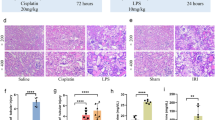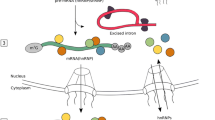Abstract
In this mini-review we give an overview of the role of mRNA-binding proteins and their associated messenger ribonucleoprotein complexes (mRNPs) in several disease states, and bring this information to bear on the pathophysiology of brain ischemia. One conclusion reached is that mRNPs may play a causal role in proteotoxicity instead of being merely passive targets. Ischemia therapies targeting mRNPs have advantages over targeting single pathways, but the behavior of mRNPs needs to be considered in the design of therapies.

Similar content being viewed by others
References
Knowles RB, Sabry JH, Martone ME, Deerinck TJ, Ellisman MH, Bassell GJ, et al. Translocation of RNA granules in living neurons. J Neurosci. 1996;16(24):7812–20.
Kedersha N, Anderson P. Regulation of translation by stress granules and processing bodies. Prog Mol Biol Transl Sci. 2009;90:155–85. https://doi.org/10.1016/S1877-1173(09)90004-7.
Kedersha NL, Gupta M, Li W, Miller I, Anderson P. RNA-binding proteins TIA-1 and TIAR link the phosphorylation of eIF-2 alpha to the assembly of mammalian stress granules. J Cell Biol. 1999;147(7):1431–42.
Kedersha N, Tisdale S, Hickman T, Anderson P. Real-time and quantitative imaging of mammalian stress granules and processing bodies. Methods Enzymol. 2008;448:521–52. https://doi.org/10.1016/S0076-6879(08)02626-8.
Aulas A, Fay MM, Szaflarski W, Kedersha N, Anderson P, Ivanov P. Methods to classify cytoplasmic foci as mammalian stress granules. J Vis Exp. 2017;123 https://doi.org/10.3791/55656.
Paz I, Kosti I, Ares M Jr, Cline M, Mandel-Gutfreund Y. RBPmap: a web server for mapping binding sites of RNA-binding proteins. Nucleic Acids Res. 2014;42(Web Server issue):W361–7. https://doi.org/10.1093/nar/gku406.
Harvey R, Dezi V, Pizzinga M, Willis AE. Post-transcriptional control of gene expression following stress: the role of RNA-binding proteins. Biochem Soc Trans. 2017;45(4):1007–14. https://doi.org/10.1042/BST20160364.
Simone LE, Keene JD. Mechanisms coordinating ELAV/Hu mRNA regulons. Curr Opin Genet Dev. 2013;23(1):35–43. https://doi.org/10.1016/j.gde.2012.12.006.
Sajjanar B, Deb R, Raina SK, Pawar S, Brahmane MP, Nirmale AV, et al. Untranslated regions (UTRs) orchestrate translation reprogramming in cellular stress responses. J Therm Biol. 2017;65:69–75. https://doi.org/10.1016/j.jtherbio.2017.02.006.
Bakheet T, Williams BR, Khabar KS. ARED 3.0: the large and diverse AU-rich transcriptome. Nucleic Acids Res. 2006;34(Database issue):D111–4. https://doi.org/10.1093/nar/gkj052.
Fan XC, Steitz JA. Overexpression of HuR, a nuclear-cytoplasmic shuttling protein, increases the in vivo stability of ARE-containing mRNAs. EMBO J. 1998;17(12):3448–60. https://doi.org/10.1093/emboj/17.12.3448.
Mazan-Mamczarz K, Galban S, Lopez de Silanes I, Martindale JL, Atasoy U, Keene JD, et al. RNA-binding protein HuR enhances p53 translation in response to ultraviolet light irradiation. Proc Natl Acad Sci U S A. 2003;100(14):8354–9. https://doi.org/10.1073/pnas.1432104100.
Gallouzi IE, Brennan CM, Steitz JA. Protein ligands mediate the CRM1-dependent export of HuR in response to heat shock. RNA. 2001;7(9):1348–61.
Antic D, Keene JD. Messenger ribonucleoprotein complexes containing human ELAV proteins: interactions with cytoskeleton and translational apparatus. J Cell Sci. 1998;111(Pt 2):183–97.
Kedersha N, Anderson P. Stress granules: sites of mRNA triage that regulate mRNA stability and translatability. Biochem Soc Trans. 2002;30(Pt 6):963–9. https://doi.org/10.1042/bst0300963.
Gilks N, Kedersha N, Ayodele M, Shen L, Stoecklin G, Dember LM, et al. Stress granule assembly is mediated by prion-like aggregation of TIA-1. Mol Biol Cell. 2004;15(12):5383–98. https://doi.org/10.1091/mbc.E04-08-0715.
Anderson P, Kedersha N, Ivanov P. Stress granules, P-bodies and cancer. Biochim Biophys Acta. 2015;1849(7):861–70. https://doi.org/10.1016/j.bbagrm.2014.11.009.
Mahboubi H, Stochaj U. Cytoplasmic stress granules: dynamic modulators of cell signaling and disease. Biochim Biophys Acta. 2017;1863(4):884–95. https://doi.org/10.1016/j.bbadis.2016.12.022.
DeGracia DJ. Regulation of mRNA following brain ischemia and reperfusion. Wiley Interdiscip Rev RNA. 2017;8(4). doi:https://doi.org/10.1002/wrna.1415.
Hossmann KA. Disturbances of cerebral protein synthesis and ischemic cell death. Prog Brain Res. 1993;96:161–77.
Kayali F, Montie HL, Rafols JA, DeGracia DJ. Prolonged translation arrest in reperfused hippocampal cornu Ammonis 1 is mediated by stress granules. Neuroscience. 2005;134(4):1223–45. https://doi.org/10.1016/j.neuroscience.2005.05.047.
Jamison JT, Kayali F, Rudolph J, Marshall M, Kimball SR, DeGracia DJ. Persistent redistribution of poly-adenylated mRNAs correlates with translation arrest and cell death following global brain ischemia and reperfusion. Neuroscience. 2008;154(2):504–20. https://doi.org/10.1016/j.neuroscience.2008.03.057.
DeGracia DJ, Rudolph J, Roberts GG, Rafols JA, Wang J. Convergence of stress granules and protein aggregates in hippocampal cornu ammonis 1 at later reperfusion following global brain ischemia. Neuroscience. 2007;146(2):562–72. https://doi.org/10.1016/j.neuroscience.2007.01.050.
Hu BR, Martone ME, Jones YZ, Liu CL. Protein aggregation after transient cerebral ischemia. J Neurosci. 2000;20(9):3191–9.
Liu CL, Ge P, Zhang F, Hu BR. Co-translational protein aggregation after transient cerebral ischemia. Neuroscience. 2005;134(4):1273–84. https://doi.org/10.1016/j.neuroscience.2005.05.015.
Ge P, Luo Y, Liu CL, Hu B. Protein aggregation and proteasome dysfunction after brain ischemia. Stroke. 2007;38(12):3230–6. https://doi.org/10.1161/STROKEAHA.107.487108.
Truettner JS, Hu K, Liu CL, Dietrich WD, Hu B. Subcellular stress response and induction of molecular chaperones and folding proteins after transient global ischemia in rats. Brain Res. 2009;1249:9–18. https://doi.org/10.1016/j.brainres.2008.10.032.
Ge P, Zhang F, Zhao J, Liu C, Sun L, Hu B. Protein degradation pathways after brain ischemia. Curr Drug Targets. 2012;13(2):159–65.
Ayuso MI, Martinez-Alonso E, Regidor I, Alcazar A. Stress granule induction after brain ischemia is independent of eukaryotic translation initiation factor (eIF) 2alpha phosphorylation and is correlated with a decrease in eIF4B and eIF4E proteins. J Biol Chem. 2016;291(53):27252–64. https://doi.org/10.1074/jbc.M116.738989.
Jin K, Li W, Nagayama T, He X, Sinor AD, Chang J, et al. Expression of the RNA-binding protein TIAR is increased in neurons after ischemic cerebral injury. J Neurosci Res. 2000;59(6):767–74. https://doi.org/10.1002/(SICI)1097-4547(20000315)59:6<767::AID-JNR9>3.0.CO;2-K.
Jin K, Mao XO, Eshoo MW, Nagayama T, Minami M, Simon RP, et al. Microarray analysis of hippocampal gene expression in global cerebral ischemia. Ann Neurol. 2001;50(1):93–103.
Wang H, Tri Anggraini F, Chen X, DeGracia DJ. Embryonic lethal abnormal vision proteins and adenine and uridine-rich element mRNAs after global cerebral ischemia and reperfusion in the rat. J Cereb Blood Flow Metab : Off J Int Soc Cereb Blood Flow Metab. 2016; https://doi.org/10.1177/0271678X16657572.
Szymanski JJ, Wang H, Jamison JT, DeGracia DJ. HuR function and translational state analysis following global brain ischemia and reperfusion. Transl Stroke Res. 2013;4(6):589–603. https://doi.org/10.1007/s12975-013-0273-2.
Cuadrado A, Navarro-Yubero C, Furneaux H, Kinter J, Sonderegger P, Munoz A. HuD binds to three AU-rich sequences in the 3′-UTR of neuroserpin mRNA and promotes the accumulation of neuroserpin mRNA and protein. Nucleic Acids Res. 2002;30(10):2202–11.
DeGracia DJ. Acute and persistent protein synthesis inhibition following cerebral reperfusion. J Neurosci Res. 2004;77(6):771–6. https://doi.org/10.1002/jnr.20225.
Ash PE, Vanderweyde TE, Youmans KL, Apicco DJ, Wolozin B. Pathological stress granules in Alzheimer’s disease. Brain Res. 2014;1584:52–8. https://doi.org/10.1016/j.brainres.2014.05.052.
Wolozin B. Physiological protein aggregation run amuck: stress granules and the genesis of neurodegenerative disease. Discov Med. 2014;17(91):47–52.
Gal J, Kuang L, Barnett KR, Zhu BZ, Shissler SC, Korotkov KV, et al. ALS mutant SOD1 interacts with G3BP1 and affects stress granule dynamics. Acta Neuropathol. 2016;132(4):563–76. https://doi.org/10.1007/s00401-016-1601-x.
Vanderweyde T, Apicco DJ, Youmans-Kidder K, Ash PEA, Cook C, Lummertz da Rocha E, et al. Interaction of tau with the RNA-binding protein TIA1 regulates tau pathophysiology and toxicity. Cell Rep. 2016;15(7):1455–66. https://doi.org/10.1016/j.celrep.2016.04.045.
Vanderweyde T, Youmans K, Liu-Yesucevitz L, Wolozin B. Role of stress granules and RNA-binding proteins in neurodegeneration: a mini-review. Gerontology. 2013;59(6):524–33. https://doi.org/10.1159/000354170.
Cestra G, Rossi S, Di Salvio M, Cozzolino M. Control of mRNA translation in ALS Proteinopathy. Front Mol Neurosci. 2017;10:85. https://doi.org/10.3389/fnmol.2017.00085.
BR H, Janelidze S, Ginsberg MD, Busto R, Perez-Pinzon M, Sick TJ, et al. Protein aggregation after focal brain ischemia and reperfusion. J Cereb Blood Flow Metab : Off J Int Soc Cereb Blood Flow Metab. 2001;21(7):865–75. https://doi.org/10.1097/00004647-200107000-00012.
Petrov T, Underwood BD, Braun B, Alousi SS, Rafols JA. Upregulation of iNOS expression and phosphorylation of eIF-2alpha are paralleled by suppression of protein synthesis in rat hypothalamus in a closed head trauma model. J Neurotrauma. 2001;18(8):799–812. https://doi.org/10.1089/089771501316919166.
Chou A, Krukowski K, Jopson T, Zhu PJ, Costa-Mattioli M, Walter P, et al. Inhibition of the integrated stress response reverses cognitive deficits after traumatic brain injury. Proc Natl Acad Sci U S A. 2017;114(31):E6420–E6. https://doi.org/10.1073/pnas.1707661114.
Wiesner D, Tar L, Linkus B, Chandrasekar A, Olde Heuvel F, Dupuis L, et al. Reversible induction of TDP-43 granules in cortical neurons after traumatic injury. Exp Neurol. 2017;299(Pt A):15–25. https://doi.org/10.1016/j.expneurol.2017.09.011.
Kwan T, Floyd CL, Patel J, Mohaimany-Aponte A, King PH. Astrocytic expression of the RNA regulator HuR accentuates spinal cord injury in the acute phase. Neurosci Lett. 2017;651:140–5. https://doi.org/10.1016/j.neulet.2017.05.003.
Beiter T, Hoene M, Prenzler F, Mooren FC, Steinacker JM, Weigert C, et al. Exercise, skeletal muscle and inflammation: ARE-binding proteins as key regulators in inflammatory and adaptive networks. Exerc Immunol Rev. 2015;21:42–57.
Grammatikakis I, Abdelmohsen K, Gorospe M. Posttranslational control of HuR function. Wiley Interdiscip Rev RNA. 2017;8(1). doi:https://doi.org/10.1002/wrna.1372.
Shang J, Zhao Z. Emerging role of HuR in inflammatory response in kidney diseases. Acta Biochim Biophys Sin Shanghai. 2017;49(9):753–63. https://doi.org/10.1093/abbs/gmx071.
Kwan T, Floyd CL, Kim S, King PH. RNA binding protein human antigen R is translocated in astrocytes following spinal cord injury and promotes the inflammatory response. J Neurotrauma. 2017;34(6):1249–59. https://doi.org/10.1089/neu.2016.4757.
Wang H, Ding N, Guo J, Xia J, Ruan Y. Dysregulation of TTP and HuR plays an important role in cancers. Tumour Biol. 2016;37(11):14451–61. https://doi.org/10.1007/s13277-016-5397-z.
Fournier MJ, Gareau C, Mazroui R. The chemotherapeutic agent bortezomib induces the formation of stress granules. Cancer Cell Int. 2010;10:12. https://doi.org/10.1186/1475-2867-10-12.
Moeller BJ, Dewhirst MW. Raising the bar: how HIF-1 helps determine tumor radiosensitivity. Cell Cycle. 2004;3(9):1107–10.
Stoecklin G, Gross B, Ming XF, Moroni C. A novel mechanism of tumor suppression by destabilizing AU-rich growth factor mRNA. Oncogene. 2003;22(23):3554–61. https://doi.org/10.1038/sj.onc.1206418.
Irvine K, Stirling R, Hume D, Kennedy D. Rasputin, more promiscuous than ever: a review of G3BP. Int J Dev Biol. 2004;48(10):1065–77. https://doi.org/10.1387/ijdb.041893ki.
Sharp FR, Kinouchi H, Koistinaho J, Chan PH, Sagar SM. HSP70 heat shock gene regulation during ischemia. Stroke. 1993;24(12 Suppl):I72–5.
VanGilder RL, Huber JD, Rosen CL, Barr TL. The transcriptome of cerebral ischemia. Brain Res Bull. 2012;88(4):313–9. https://doi.org/10.1016/j.brainresbull.2012.02.002.
Lloyd RE. Translational control by viral proteinases. Virus Res. 2006;119(1):76–88. https://doi.org/10.1016/j.virusres.2005.10.016.
Yim HC, Williams BR. Protein kinase R and the inflammasome. J Interf Cytokine Res. 2014;34(6):447–54. https://doi.org/10.1089/jir.2014.0008.
Dabo S, Meurs EF. dsRNA-dependent protein kinase PKR and its role in stress, signaling and HCV infection. Viruses. 2012;4(11):2598–635. https://doi.org/10.3390/v4112598.
McCormick C, Khaperskyy DA. Translation inhibition and stress granules in the antiviral immune response. Nat Rev Immunol. 2017;17(10):647–60. https://doi.org/10.1038/nri.2017.63.
Montero H, Trujillo-Alonso V. Stress granules in the viral replication cycle. Viruses. 2011;3(11):2328–38. https://doi.org/10.3390/v3112328.
O'Collins VE, Macleod MR, Donnan GA, Horky LL, van der Worp BH, Howells DW. 1,026 experimental treatments in acute stroke. Ann Neurol. 2006;59(3):467–77. https://doi.org/10.1002/ana.20741.
Uversky VN. Intrinsically disordered proteins in overcrowded milieu: membrane-less organelles, phase separation, and intrinsic disorder. Curr Opin Struct Biol. 2017;44:18–30. https://doi.org/10.1016/j.sbi.2016.10.015.
Saarikangas J, Barral Y. Protein aggregation as a mechanism of adaptive cellular responses. Curr Genet. 2016;62(4):711–24. https://doi.org/10.1007/s00294-016-0596-0.
Funding
This work was supported by NIH Grants No. NS081347 (D.J.D.).
Author information
Authors and Affiliations
Corresponding author
Ethics declarations
Conflict of Interest
The author declares no conflict of interest. The present work is a review article and does not directly involve animal or human research.
Rights and permissions
About this article
Cite this article
DeGracia, D.J. Disease of mRNA Regulation: Relevance for Ischemic Brain Injury. Transl. Stroke Res. 9, 251–257 (2018). https://doi.org/10.1007/s12975-017-0586-7
Received:
Revised:
Accepted:
Published:
Issue Date:
DOI: https://doi.org/10.1007/s12975-017-0586-7




